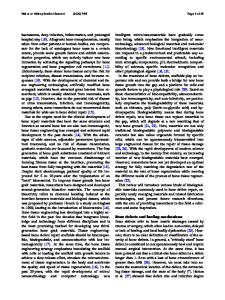Magnesium-based Biodegradable Nanostructured Substrates: Hybrid Materials for Cellular Engraftment
- PDF / 1,169,980 Bytes
- 7 Pages / 612 x 792 pts (letter) Page_size
- 8 Downloads / 381 Views
1235-RR03-45
Magnesium-based biodegradable nanostructured substrates: Hybrid materials for cellular engraftment Tobias Schoen1, Tobias Wolfram1, and Joachim P Spatz.1 1 Department of New Materials and Biosystems, Max-Planck-Institute for Metals Research, and Department of Biophysical Chemistry, University of Heidelberg, Heisenbergstr. 3, D-70569 Stuttgart, Germany ABSTRACT Magnesium and its alloys are used as implants because of their biocompatibility and high strength-to-weight ratio. In contrast to other commonly used implantable materials such as stainless steel and Co-Cr-alloys, which may release toxic metallic ions, magnesium belongs to the natural composition of the human body. Our work is focused on engineering a cellular carrier system based on biodegradable magnesium and magnesium alloy substrates, which are decorated with gold nanoparticles to form magnesium-gold (Mg-Au) hybrid materials. Specifically, we deposited gold nanoparticles on MgO single crystals (100 orientation) and on AZ31-Mg alloy substrates using diblock copolymer micelle nanolithography. The gold nanoparticles were arranged in ordered arrays with controllable interparticle distances of 25 to 300 nm and were further functionalized with RGD-thiols or fibronectin. This method allowed the deposition of a protein carpet on top of the surface and facilitated the initial adhesion of cells on the magnesium substrates. In order to determine the stability of the substrates in a physiological environment, their corrosive behavior was studied by comparing the weight of the substrates before and after a 24h-long submersion in water, PBS, or cell culture medium and by studying the post-submersion surface morphology with scanning electron microscopy. Corrosion rates of magnesium substrates in PBS and cell culture medium were significantly higher than in water. The spreading and survival of C2C12 mouse myoblasts and human mesenchymal stem cells cultured on MgO single crystals and AZ31-alloys were investigated with fluorescence and phase contrast microscopy. The spreading and survival of C2C12 myoblasts on the Mg-Au hybrid materials were different than on non-functionalized Mg substrates. Additionally, cells on non-functionalized MgO crystals showed reduced filopodia activity. Our results show that biofunctionalized and engineered magnesium-based substrates can be used as carriers for different cellular systems and promising initial steps have been taken towards an implantable device with a defined biological surface activity made from magnesium materials. INTRODUCTION The effort to use magnesium as a bioabsorbable implant has been undertaken for over 100 years [1]. In contrast to conventional implant metals which may release toxic ions, magnesium belongs to the natural composition of the human organism and may even be absorbed as a beneficial electrolyte. Magnesium ions influence integrin activity and accelerate cell adhesion [4]. Because of its high biocompatibility and good mechanical properties, magnesium implants are used in stents and orthopaedic bio
Data Loading...











